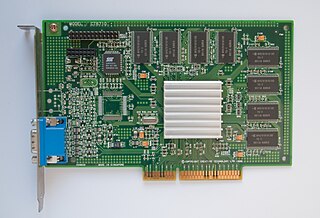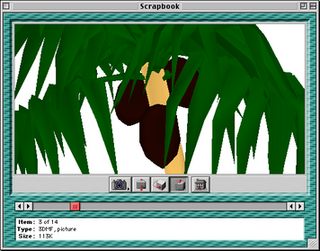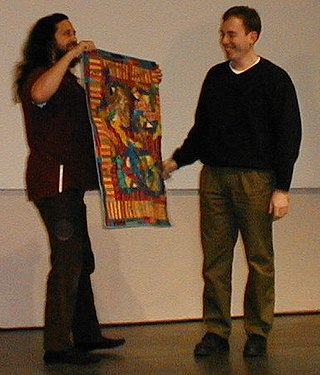
OpenGL is a cross-language, cross-platform application programming interface (API) for rendering 2D and 3D vector graphics. The API is typically used to interact with a graphics processing unit (GPU), to achieve hardware-accelerated rendering.

The GeForce 256 is the original release in Nvidia's "GeForce" product line. Announced on August 31, 1999 and released on October 11, 1999, the GeForce 256 improves on its predecessor by increasing the number of fixed pixel pipelines, offloading host geometry calculations to a hardware transform and lighting (T&L) engine, and adding hardware motion compensation for MPEG-2 video. It offered a notably large leap in 3D PC gaming performance and was the first fully Direct3D 7-compliant 3D accelerator.

3dfx Interactive, Inc. was an American computer hardware company headquartered in San Jose, California, founded in 1994, that specialized in the manufacturing of 3D graphics processing units, and later, video cards. It was a pioneer in the field from the late 1990s to 2000.

A graphics processing unit (GPU) is a specialized electronic circuit initially designed to accelerate computer graphics and image processing. After their initial design, GPUs were found to be useful for non-graphic calculations involving embarrassingly parallel problems due to their parallel structure. Other non-graphical uses include the training of neural networks and cryptocurrency mining.

OpenAL is a cross-platform audio application programming interface (API). It is designed for efficient rendering of multichannel three-dimensional positional audio. Its API style and conventions deliberately resemble those of OpenGL. OpenAL is an environmental 3D audio library, which can add realism to a game by simulating attenuation, the Doppler effect, and material densities.

Released in August 1997 by Nvidia, the RIVA 128, or "NV3", was one of the first consumer graphics processing units to integrate 3D acceleration in addition to traditional 2D and video acceleration. Its name is an acronym for Real-time Interactive Video and Animation accelerator.

The RIVA TNT, codenamed NV4, is a 2D, video, and 3D graphics accelerator chip for PCs that was developed by Nvidia and released in March 1998. It cemented Nvidia's reputation as a worthy rival within the developing consumer 3D graphics adapter industry. It succeeded the RIVA 128.

The RIVA TNT2 is a graphics processing unit manufactured by Nvidia starting in early 1999. The chip is codenamed "NV5" because it is the 5th graphics chip design by Nvidia, succeeding the RIVA TNT (NV4). RIVA is an acronym for Real-time Interactive Video and Animation accelerator. The "TNT" suffix refers to the chip's ability to work on two texels at once. Nvidia removed RIVA from the name later in the chip's lifetime.

QuickDraw 3D, or QD3D for short, is a 3D graphics API developed by Apple Inc. starting in 1995, originally for their Macintosh computers, but delivered as a cross-platform system.
Direct3D and OpenGL are both application programming interfaces (APIs) that can be used in applications to render 2D and 3D computer graphics. As of 2005, graphics processing units (GPUs) almost always implement one version of both of these APIs. Examples include: DirectX 9 and OpenGL 2 circa 2004; DirectX 10 and OpenGL 3 circa 2008; and most recently, DirectX 11 and OpenGL 4 circa 2011. GPUs that support more recent versions of the standards are backwards compatible with applications that use the older standards; for example, one can run older DirectX 9 games on a more recent DirectX 11-certified GPU.
MiniGL is an incomplete implementation of the OpenGL specification which implements enough of the API to allow 3D video games in the late 1990s to run with hardware acceleration on contemporary graphics cards, which otherwise provided their own APIs. The original implementation came from 3dfx Interactive, and was designed around supporting Quake. Other companies implementing similar software included PowerVR and Rendition.
Mesa, also called Mesa3D and The Mesa 3D Graphics Library, is an open source implementation of OpenGL, Vulkan, and other graphics API specifications. Mesa translates these specifications to vendor-specific graphics hardware drivers.

Brian E. Paul is a computer programmer who originally wrote and maintained the source code for the open source Mesa graphics library until 2012, and is still active in the project. He began writing its source code in August 1993. Mesa is a free software/open source graphics library that provides a generic OpenGL implementation for rendering three-dimensional graphics on multiple platforms.

Diamond Multimedia is an American company that specializes in many forms of multimedia technology. They have produced graphics cards, motherboards, modems, sound cards and MP3 players; however, the company began with the production of the TrackStar, a PC add-on card which emulated Apple II computers. They were one of the major players in the 2D and early 3D graphics card competition throughout the 1990s and early 2000s.

Rendition, Inc., was a maker of 3D computer graphics chipsets in the mid to late 1990s. They were known for products such as the Vérité 1000 and Vérité 2x00 and for being one of the first 3D chipset makers to directly work with Quake developer John Carmack to make a hardware-accelerated version of the game (vQuake). Rendition's major competitor at the time was 3Dfx. Their proprietary rendering APIs were Speedy3D and RRedline.

A free and open-source graphics device driver is a software stack which controls computer-graphics hardware and supports graphics-rendering application programming interfaces (APIs) and is released under a free and open-source software license. Graphics device drivers are written for specific hardware to work within a specific operating system kernel and to support a range of APIs used by applications to access the graphics hardware. They may also control output to the display if the display driver is part of the graphics hardware. Most free and open-source graphics device drivers are developed by the Mesa project. The driver is made up of a compiler, a rendering API, and software which manages access to the graphics hardware.
The G400 is a video card made by Matrox, released in September 1999. The graphics processor contains a 2D GUI, video, and Direct3D 6.0 3D accelerator. Codenamed "Toucan", it was a more powerful and refined version of its predecessor, the G200.
Warp3D was a project, founded by Haage & Partner in 1998, that aimed to provide a standard API which would enable programmers to access, and therefore use, 3D hardware on the Amiga.

The Voodoo2 is a set of three specialized 3D graphics chips on a single chipset setup, made by 3dfx. It was released in February 1998 as a replacement for the original Voodoo Graphics chipset. The card runs at a chipset clock rate of 90 MHz and uses 100 MHz EDO DRAM, and is available for the PCI interface. The Voodoo2 comes in two models, one with 8 MB RAM and one with 12 MB RAM. The 8 MB card has 2 MB of memory per texture mapping unit (TMU) vs. 4 MB on the 12 MB model. The 4 MB framebuffer on both cards support a maximum screen resolution of 800 × 600, while the increased texture memory on the 12 MB card allows more detailed textures. Some boards with 8 MB can be upgraded to 12 MB with an additional daughter board.













